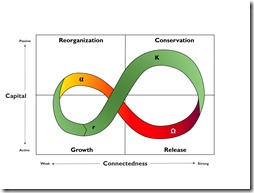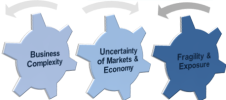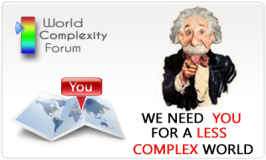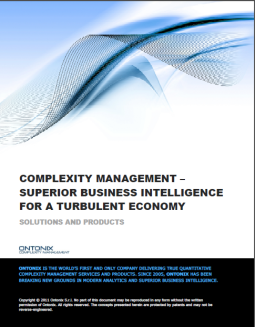Friday, 2 September, 2011
It is fair to say that the (adapted) words of “Occam’s razor” are as valid in 21st Century as they were in the 14th!
Pluralitas non est ponenda sine neccesitate
For those of us whose knowledge of Latin didn’t extend beyond ‘O’ Level, this is roughly translated as: Entities should not be multiplied unnecessarily.
However a more familiar quote, oft attributed to Einstein, that expresses what William of Ockham was telling us, is: “Everything should be made as simple as possible, but not simpler.”
In modernity we have, unwittingly, come to rely upon levels of complexity in communications, products and services that were the stuff of science fiction in our own life-times…that does pre-suppose that your are old enough to remember Colour television as the preserve of an affluent minority!
But, if we should be striving for simplicity, THE question is: how can we reduce complexity without losing functionality?
Ontonix quantify current complexity and, more importantly, the point of “critical complexity” beyond which loss of function, failure or collapse are assured. We contest that, without a means to, objectively, quantify system complexity the ability to simplify – without loss of function – is impossible as there is no means to “track” causality!
I have read some experts (and consultants) talking about adding “good complexity” and removing “bad complexity”. Great! That makes sense, but if defining complexity has been the source of much Academic “mental masturbation” for over 30 years – without unilateral agreement – I would suggest that this amounts to little more than a sales pitch for consultancy services! Read more of this post




























 Like him or not, agree with him or not you can’t say that Nassim Taleb (NNT) isn’t “good value”!? He wears his heart on his sleeve and says what he thinks.
Like him or not, agree with him or not you can’t say that Nassim Taleb (NNT) isn’t “good value”!? He wears his heart on his sleeve and says what he thinks.
 AS PROTESTS against financial power sweep the world this week, science may have confirmed the protesters’ worst fears. An analysis of the relationships between 43,000 transnational corporations has identified a relatively small group of companies, mainly banks, with disproportionate power over the global economy.
AS PROTESTS against financial power sweep the world this week, science may have confirmed the protesters’ worst fears. An analysis of the relationships between 43,000 transnational corporations has identified a relatively small group of companies, mainly banks, with disproportionate power over the global economy. In the intervening period a great deal has changed…not necessarily for the better. But too much has remained the same. As I read recently “Nowadays, competition is mainly taking place between business models rather than just between products and services…”. It is true.
In the intervening period a great deal has changed…not necessarily for the better. But too much has remained the same. As I read recently “Nowadays, competition is mainly taking place between business models rather than just between products and services…”. It is true. 











